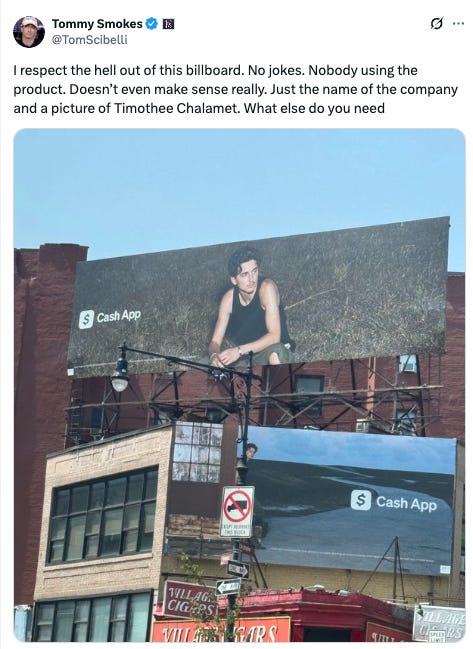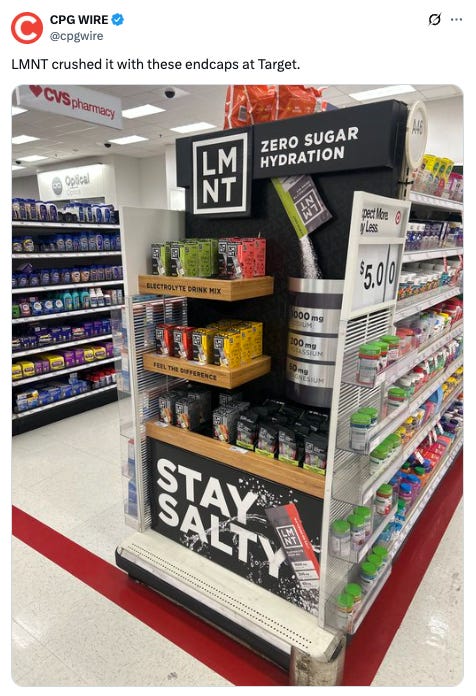You're telling me a brand made this strategy?
sweatshirts as cultural discourse, IG repost tactics
This week, Oren is considering fashion as fragrance marketing, while Clayton is upsetting NPCs everywhere with a sweatpants/sweatshirt conundrum.
In this week’s HYPER we discuss the steps to building out an influencer marketing program, share 10 ad types to consider for your brand, and go into a kitchen sink on what’s happening in social and performance on the internet.
Let’s begin.
Building a Great Influencer Marketing Program
If I was building a creator marketing program today, here’s the playbook I’d follow. This applies whether you’re a brand starting fresh, or you're tired of working with influencers but having it move the needle how you’d expect it. As many of you know, I’ve worked with hundreds of influencers per season at my last CMO job, and now do strategy on consistent campaigns where I can leverage my perspective as a creator, and I think this is a very effective toolkit.
Step 1: Build a Creator List
Start by assembling a big list of creators in your niche-I would capture as many as possible to pare down, because you’ll only get a fraction that respond.. Not just who’s done ads before—who actually fits. Later (who’ve partnered on this newsletter) has a database with over 10 million creators to start with, and you can filter by platform, location, audience size, and content type. They also have a team that will help do it for you as well!
Step 2: Structure Your Campaign for More Than One Post
Too many brands ask for one post and call it a day or pick just one network. Here’s what I feel is a better format:
First post: Have them recreate a piece of content that already worked well for them or for you—but now with your product in it. You’re leaning on proven formats. We’ve seen this with Reformation having creators remake viral videos wearing their dresses, or creators getting brands in their recurring series.
Second post: This is where you can give creative freedom, or stick to your campaign brief if you’ve got a great one. But you’re doing this once you already have something you know their audience resonates with from post 1, so you’re building on familiarity.
And don’t limit the scope. If they’re active on multiple platforms—YouTube, TikTok, email, Instagram—bundle in the ones that make sense and go wider. You want to see the full range of what they can do, it takes multiple touchpoints to resonate.
Pro tip: Before anything goes live, send over your best content examples, packaging, creative references, or props you could send (even locations they might be able to access). Give them everything they need to shoot something great. If they know that in advance they can structure content to match it and come with interesting ideas.
Step 3: Whitelist and Run Paid Tests
Include whitelisting in your campaigns and test in everywhere you place spend
Use it as UGC in your Meta campaigns (with ASC especially)
Run it as Spark Ads on TikTok
Compare it against your in-house creative to get a baseline of what does better, and how long its effective for, this can help you better configure rates you’re willing to pay and look at volume of creative in house, versus UGC, versus influence
Recommendations1. Make It Feel Like a Moment
Don’t always space things out randomly or monthly. Cluster your creator drops together. Make the briefs feel connected with props or themes. Tie it to something happening in your organic content. When it all hits at once, it feels like it's resonating, like you’re making a moment.
2. Back Your Creators Early
Your best creators are often on the verge of doing something bigger or scheming on their next series or release. Ask them what they’re planning. Support their ideas early and you have a high chance of low cost to outsize value if it breaks out.
Everything I just mentioned - you can run all of this with Later. Their platform lets you
Discover and connect with creators
Run full funnel campaigns in one platform
And if you don’t want to do it all yourself, their experienced team can help you manage the whole thing from recruiting to briefs to analytics and more
This segment is in partnership with Later
The Art of Advertising
This week I did a new Youtube video, that’s an hour long breaking down positioning, pyschology, ad formats and basics of all the networks, featuring my friend Lucas from Darkroom (100+ person performance agency). Worth the watch if you’re diving in.
I also cherry-picked ad types discussed in here you should consider adding to your toolkit!
Ad types for your toolkit
1. Problem–Solution
Frame the pain first. Then solve it.
Show the customer struggling. Make it relatable and specific.
Introduce your product as the clear, obvious fix.
Example:
“You’re Not You When You’re Hungry” – Snickers
2. Founder Story
Founders are built-in characters. Use their story to build trust and differentiate.
What frustrated them?
What gap did they see?
What did they build to fix it?
3. Reaction/Testimonial
Use real people and show reactions in real time or capture testimonials after use.
Best when product performance is strong and visible.
4. Listicle Ad
Use structure to drive engagement - include your product in a longer list of solutions for an ideal consumer lifestyle.
5. Justify a Selfish Desire
People want to indulge — help them feel smart for doing it.
Frame the purchase as an investment, a reward, or a deeper value.
It’s not just skincare. It’s self-care.
It’s not just a candle. It’s a mood reset.
Example, luxury reframed as legacy from a legendary ad
“You never actually own a Patek Philippe, you merely look after it for the next generation.”
6. Prove it
Nothing beats proof.
Examples:
“Shot on iPhone” — the ad is the result, beautiful
“Will It Blend?” — stress-testing to the extreme (or the viral)
7. POV Ads
Put the viewer in the scene.
Use first-person perspective to build immersion.
Works especially well for TikTok and IG Reels.
Show the lifestyle they want to have — subtly tied to your product.
8. Transformation Arc
A full journey — not just a product moment.
Introduce the person or situation
Walk through the discovery or struggle
End with the result — and how it changed their day/life/mindset
Strong for products that require a little education or emotional connection.
Great for high-consideration purchases or subscription models - can also swap and lead with the result, then walk back through the journey.
9. Expert Breakdown
Credibility sells. Especially in technical or crowded markets.
Bring in a subject-matter expert to explain the product
Could be a doctor, chef, athlete, dermatologist, or designer
Or feature someone from the team if they’re credible on-camera
Can’t recommend this one enough.
10. Remix / Q&A
Use social proof and interaction to drive content.
Take a real comment or question
Put it on-screen as the hook
Answer it in a way that educates or entertains
This builds community, shows you’re listening, and keeps your ads feeling human.
Great for:
Sizing questions
Ingredient concerns
Use-case clarifications
Criticism turned into marketing
11. Contrarian Take
Lead with a hot take to stop the scroll, get the discussion going in the comments, force viewers to take a stand. This format wins attention because it challenges common sense, it’s native to platform. Most brands wont do this because its “off brand” but the ones that will can crush.
Kitchen Sink
Instagram has a new repost button, Chris coming through with a great insight on how to use it.
Rachel the 🐐 reminding you to get your brand doing episodic content on social.
Cash app marketing to Gen-Z with pure vibes and I will take accept no marketing guru slander.
This is the new standard for in-store POS.
Paul (runs a influencer-driven beauty brand) with a reminder of how many touchpoint customers need to convert, and also how complicated attribution is.
This is your sign to drop an ad of your team calling your top customers. I love looking at Brez because I worked in category and consumed a lot in the beverage space here, where there were tons of entrenched brands, and then watched them come in with a well branded, more expensive, on-par offering to existing products (at best, I kinda prefer the others) and then just absolutely dominate by pure aggression and the highest levels of marketing acumen possible. Legendary run.
If you dont have a massive video catalog this isn’t for you… but if you do:
Hyper Reports
Check out our market reports. We spend many hours researching markets, categories, and brands & products within the consumer space so you don’t have to.











Those ad ideas are legendary! Could you make some content about doing influencer marketing for a luxury fashion brand? Thank you!
Thank you for these recourses!